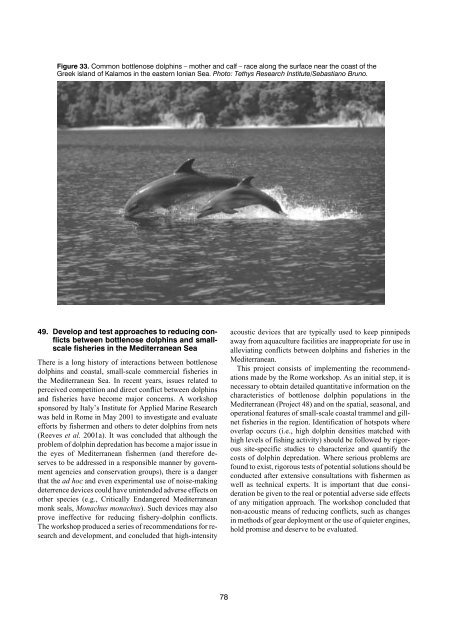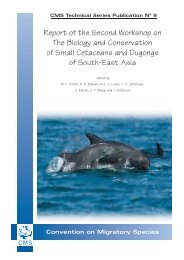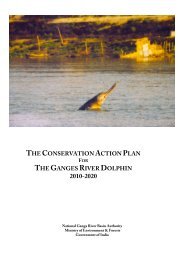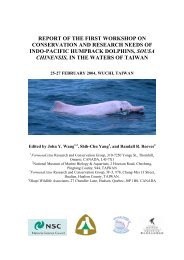Dolphins, Whales and Porpoises: 2002-2010 Conservation - IUCN
Dolphins, Whales and Porpoises: 2002-2010 Conservation - IUCN
Dolphins, Whales and Porpoises: 2002-2010 Conservation - IUCN
You also want an ePaper? Increase the reach of your titles
YUMPU automatically turns print PDFs into web optimized ePapers that Google loves.
Figure 33. Common bottlenose dolphins – mother <strong>and</strong> calf – race along the surface near the coast of the<br />
Greek isl<strong>and</strong> of Kalamos in the eastern Ionian Sea. Photo: Tethys Research Institute/Sebastiano Bruno.<br />
49. Develop <strong>and</strong> test approaches to reducing conflicts<br />
between bottlenose dolphins <strong>and</strong> smallscale<br />
fisheries in the Mediterranean Sea<br />
There is a long history of interactions between bottlenose<br />
dolphins <strong>and</strong> coastal, small-scale commercial fisheries in<br />
the Mediterranean Sea. In recent years, issues related to<br />
perceived competition <strong>and</strong> direct conflict between dolphins<br />
<strong>and</strong> fisheries have become major concerns. A workshop<br />
sponsored by Italy’s Institute for Applied Marine Research<br />
was held in Rome in May 2001 to investigate <strong>and</strong> evaluate<br />
efforts by fishermen <strong>and</strong> others to deter dolphins from nets<br />
(Reeves et al. 2001a). It was concluded that although the<br />
problem of dolphin depredation has become a major issue in<br />
the eyes of Mediterranean fishermen (<strong>and</strong> therefore deserves<br />
to be addressed in a responsible manner by government<br />
agencies <strong>and</strong> conservation groups), there is a danger<br />
that the ad hoc <strong>and</strong> even experimental use of noise-making<br />
deterrence devices could have unintended adverse effects on<br />
other species (e.g., Critically Endangered Mediterranean<br />
monk seals, Monachus monachus). Such devices may also<br />
prove ineffective for reducing fishery-dolphin conflicts.<br />
The workshop produced a series of recommendations for research<br />
<strong>and</strong> development, <strong>and</strong> concluded that high-intensity<br />
acoustic devices that are typically used to keep pinnipeds<br />
away from aquaculture facilities are inappropriate for use in<br />
alleviating conflicts between dolphins <strong>and</strong> fisheries in the<br />
Mediterranean.<br />
This project consists of implementing the recommendations<br />
made by the Rome workshop. As an initial step, it is<br />
necessary to obtain detailed quantitative information on the<br />
characteristics of bottlenose dolphin populations in the<br />
Mediterranean (Project 48) <strong>and</strong> on the spatial, seasonal, <strong>and</strong><br />
operational features of small-scale coastal trammel <strong>and</strong> gillnet<br />
fisheries in the region. Identification of hotspots where<br />
overlap occurs (i.e., high dolphin densities matched with<br />
high levels of fishing activity) should be followed by rigorous<br />
site-specific studies to characterize <strong>and</strong> quantify the<br />
costs of dolphin depredation. Where serious problems are<br />
found to exist, rigorous tests of potential solutions should be<br />
conducted after extensive consultations with fishermen as<br />
well as technical experts. It is important that due consideration<br />
be given to the real or potential adverse side effects<br />
of any mitigation approach. The workshop concluded that<br />
non-acoustic means of reducing conflicts, such as changes<br />
in methods of gear deployment or the use of quieter engines,<br />
hold promise <strong>and</strong> deserve to be evaluated.<br />
78





